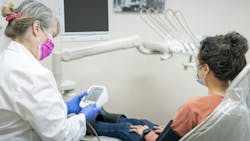Asking for a Friend: Should I be treating patients with hypertensive crisis readings?
What you'll learn in this article
- How to apply the latest AHA and ACC blood pressure guidelines to dental hygiene appointments and respond appropriately to hypertensive crisis readings
- Strategies for addressing patient resistance and effectively communicating the importance of blood pressure monitoring in the dental setting
- How to navigate office protocols and strengthen collaboration with medical professionals to ensure patient safety and continuity of care
Taking blood pressure readings at the start of our appointments demonstrates patient care that is crucial in mitigating the risk of a cardiovascular event or stroke for our patients. In fact, hypertension burdens are escalating by the year, and the number one reason why cardiovascular-related deaths are so prevalent in the US is due to the lack of early detection and treatment.
When using the current guidelines jointly issued this year by the American Heart Association (AHA) and the American College of Cardiology (ACC), you'll see there are (hopefully infrequent) times when your patients fall within the hypertensive crisis category, which is a systolic reading higher than 180 and/or a diastolic reading higher than 120.1 This category advises a person to seek immediate medical help—specifically, calling the patient’s primary care physician if symptomatic or calling 911 if accompanied with symptoms such as chest or back pain, shortness of breath, numbness or weakness, or changes in vision or speech.
Is our best method of aid proceeding with the hygiene visit, or should we customize our care? In the office where you work, are you permitted to do so?
Further reading: Oral health and high blood pressure: Is there a connection?
Obstacle 1: Patient resistance
The first obstacle will likely be helping the patient understand the severity of their blood pressure reading. The patient may not believe the reading is accurate and recall a visit with their physician where it was “fine.”
According to new data from the Centers for Disease Control and Prevention (CDC),2 nearly 48% of adults in the US live with what's referred to as the silent killer, and accurate screenings may be infrequent. Furthermore, they may be quick to attribute their blood pressure to white coat hypertension.
Ask them why they think their blood pressure is high at the dentist. If they answer that it is due to rushing or stress, I point out all the other events in the day that could produce a similar outcome and how that chronic fluctuation can impact their cardiovascular health. I also share how true stress-related increases in blood pressure have accompanying tachycardia and only increase the systolic reading by approximately 10 points, meaning a hypertensive crisis reading in the office certainly does not reflect a blood pressure that is otherwise healthy.3
Obstacle 2: Office protocols
Where you work may determine how you handle this situation. Questions to ask yourself:
- Are you supported in your decisions not to treat patients with hypertensive crisis readings and instead direct them to seek immediate care?
- Will the dentist get involved and support your recommendations?
- If the patient reported symptoms such as shortness of breath or shoulder pain with a high blood pressure reading, would you call an ambulance?
- Would you require medical clearance for a patient to return?
- Are you equipped to contact the patient’s primary care physician or cardiologist directly and relay your concerns?
- Do you have the knowledge and confidence to start the conversation that could save a patient's life?
Obstacle 3: Allied communication
There has been nothing more frustrating in my career than getting a patient with hypertensive concerns on board with being proactive about their health, just for a physician to tell them, “Well, you were at the dentist; that's why it was high.”
To avoid this, it's most beneficial to be involved on the medical side. Organizations such as the National Network of Healthcare Hygienists promote collaborative efforts between hygienists and allied health-care providers to bridge communication gaps and foster a deeper integration of dental and medical patient care. At a minimum, we should obtain the names of physicians and cardiologists so that we can communicate with them directly.
Write this script
After taking three spaced-out readings, here is an example of what you can say to help your patient if the reading remains in the highest range.
Mrs. Doe, I am concerned about your blood pressure readings today. I understand that this is not the most exciting place to be, but we take these readings to screen for health risks and to proceed with treatments safely, rather than to determine if you love coming here or not.
According to the 2025 blood pressure guidelines, you are in a range categorized as hypertensive crisis, and the recommendation is immediate medical attention. I understand this may surprise you, as you might be feeling just fine, but that is precisely why we screen your blood pressure here, since high blood pressure is often asymptomatic until an emergency occurs.
With today's readings, I'm not able to use a local anesthetic or proceed with any hygiene treatment safely. Instead, I'd like for you to call your physician and be seen by a medical provider today. I can send you with a list of your readings and current guidelines to reference when you call, and I can personally follow up with your physician. If you'd like, I can contact someone from your HIPPA form and have them pick you up from the office to drive you.
I will be thinking of you for the rest of the day and ask that you follow up with me within the next 24 hours so that I know you are okay. We will get you scheduled back as soon as this is better controlled.
Editor’s note: This article first appeared in Clinical Insights newsletter, a publication of the Endeavor Business Media Dental Group. Read more articles and subscribe.
References
- Understanding blood pressure readings. American Heart Association. December 18, 2024. Reviewed August 14, 2025. https://www.heart.org/en/health-topics/high-blood-pressure/understanding-blood-pressure-readings
- New blood pressure guidelines 2025: pathways to heart health and longevity. Healthcare Readers. August 30, 2025. https://healthcarereaders.com/news/aha-acc-blood-pressure-guidelines
- Bale B, Doneen A. Beat the Heart Attack Gene. Turner Publishing Company; 2014:49.
About the Author

Erika Lauren Serrano, RDH
Erika Lauren Serrano, RDH, is a clinical dental hygienist in Virginia with advanced training in periodontics. Her degree in writing has led her to be a proud content contributor to the health, wellness, and dental fields.
